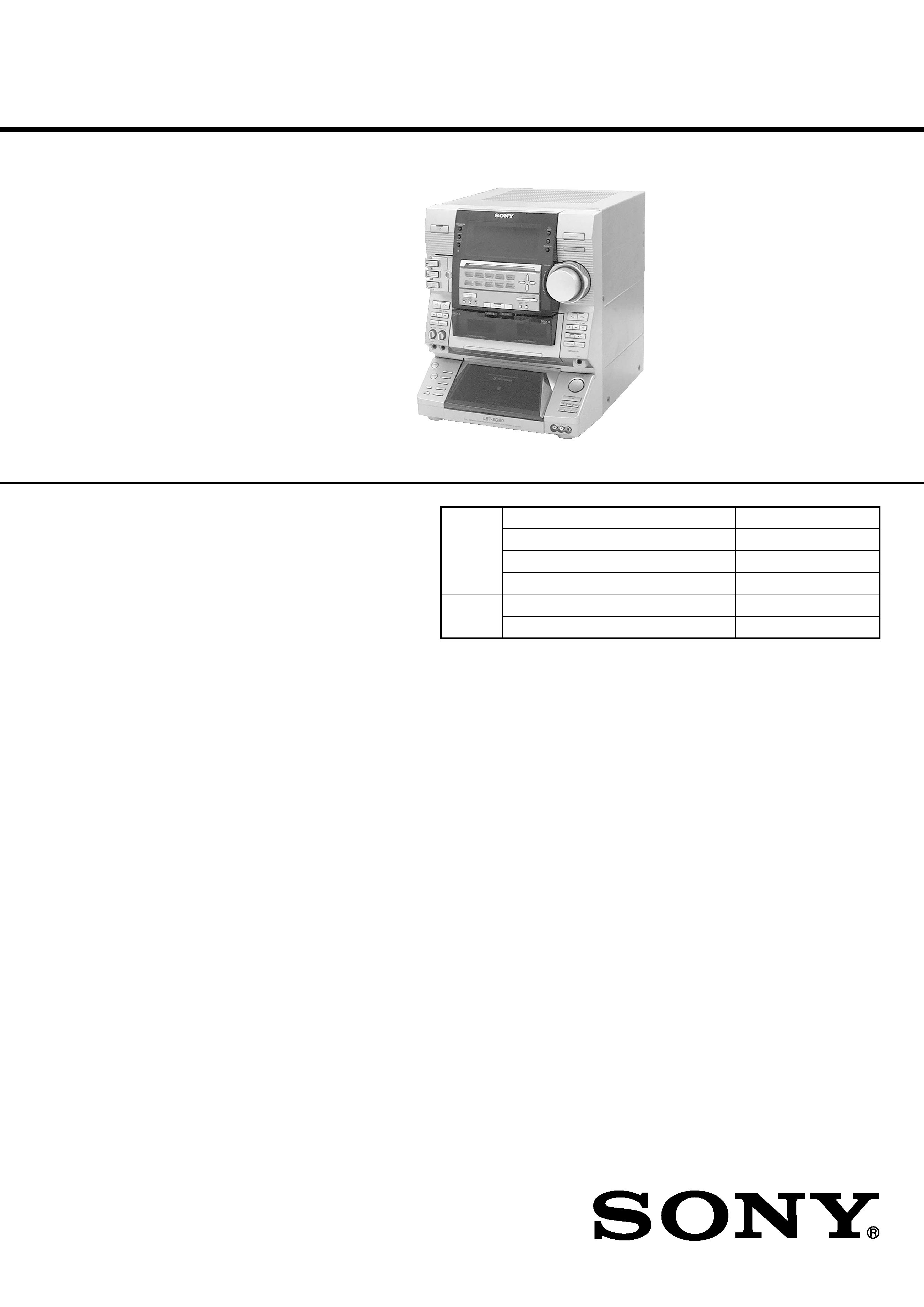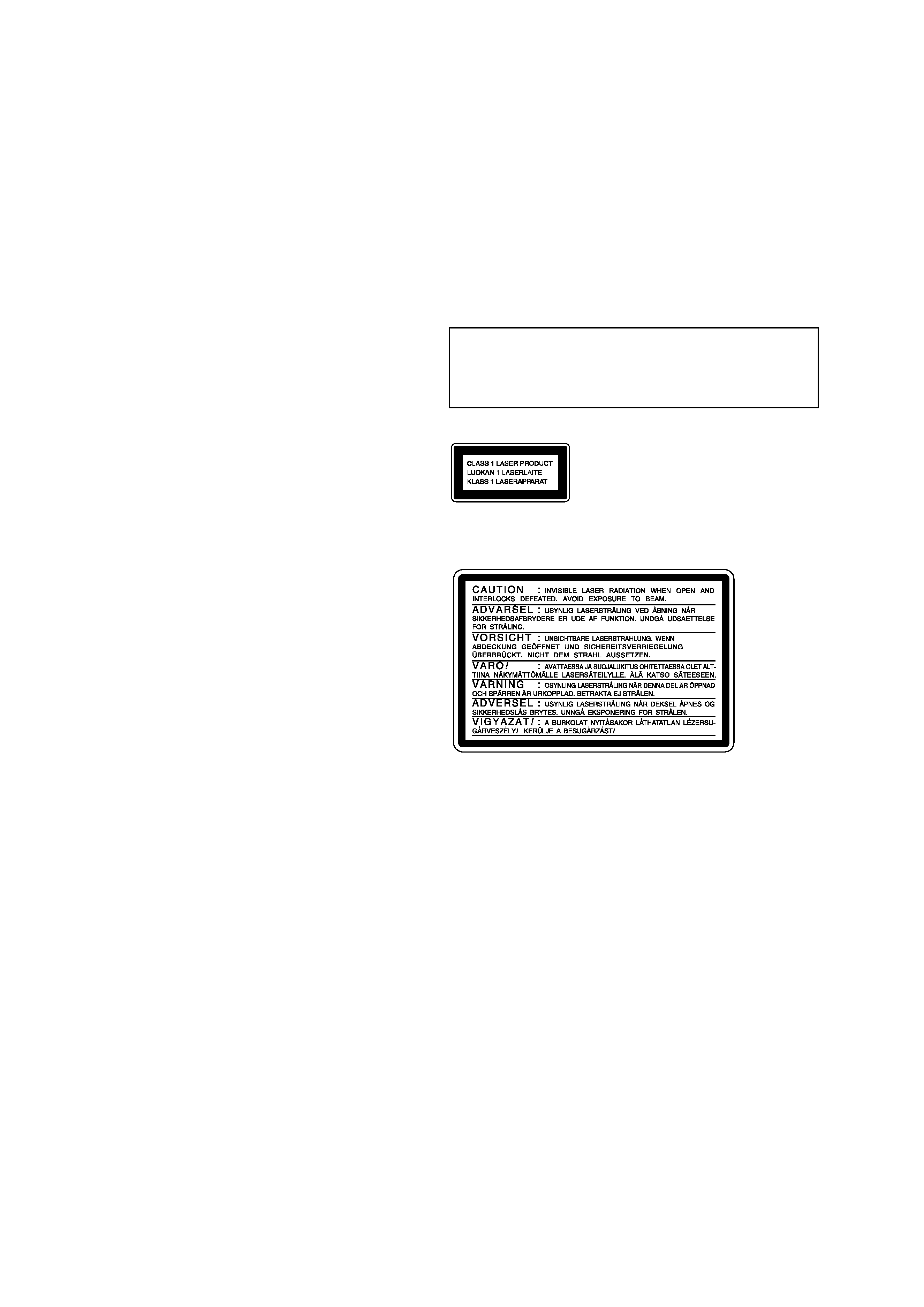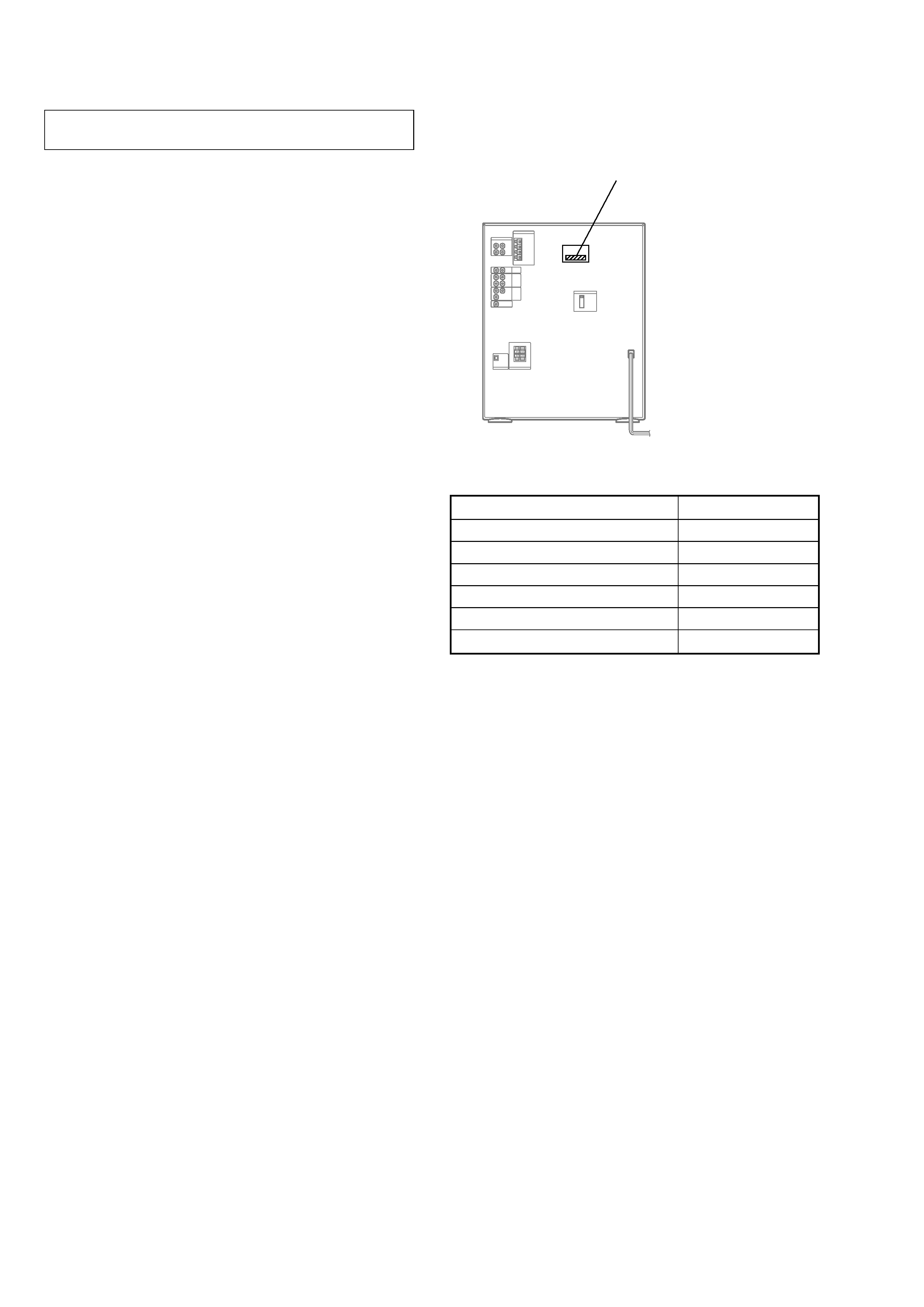
SERVICE MANUAL
Amplifier section
AEP, UK models:
DIN power output (rated) 200 + 200 watts
(6 ohms at 1 kHz, DIN)
Continuous RMS power output (reference)
250 + 250 watts
(6 ohms at 1 kHz, 10% THD)
Music power output (reference)
430 + 430 watts
(6 ohms at 1 kHz, 10% THD)
Other models:
The following measured at AC 120/220/240V, 50 Hz
DIN power output (rated) 240 + 240 watts
(4 ohms at 1 kHz, DIN)
Continuous RMS power output (reference)
320 + 320 watts
(4 ohms at 1 kHz, 10% THD)
VIDEO IN:
(phono jacks)
sensitivity 250 mV,
impedance 47 kilohms
Inputs
DJ MIX*:
(phono jacks)
sensitivity 250 mV,
impedance 47 kilohms
GUITAR IN:
(phone jack)
sensitivity 75 mV,
impedance 470 kilohms
PHONO IN:
(phono jacks)
sensitivity 3 mV,
impedance 47 kilohms
MIX MIC:
(phone jack)
sensitivity 1 mV,
impedance 10 kilohms
GAME IN:
(phono jacks)
sensitivity 250 mV,
impedance 47 kilohms
MD IN:
(phono jack)
sensitivity 450 mV,
impedance 47 kilohms
Outputs
DJ MIX*:
(phono jacks)
sensitivity 250 mV,
impedance 1 kilohms
PHONES:
(stereo phone jack)
accepts headphones of 8
ohms or more
VIDEO OUT:
(phono jack)
voltage 250 mV
impedance 1 kilohm
MD OUT:
(phono jacks)
voltage 250 mV
impedance 1 kilohm
FRONT SPEAKER:
HCD-XG80:
accepts impedance of 4 to
16 ohms
HCD-XG700:
accepts impedance of 6 to
16 ohms
* AEP, UK and Mexican models only
CD player section
System
Compact disc and digital
audio system
Laser
Semiconductor laser
(
=780nm), Emission
duration: continuous
Wavelength
780 790 nm
Frequency response
2 Hz 20 kHz (
±0.5 dB)
Signal-to-noise ratio
More than 90 dB
Dynamic range
More than 90 dB
CD OPTICAL DIGITAL OUT
(Square optical connector jack, rear panel)
Wavelength:
660 nm
Output level
18 dBm
Tape player section
Recording system
4-track 2-channel stereo
Frequency response
40 13,000 Hz (
±3 dB),
(DOLBY NR OFF)
using Sony TYPE I cassette
40 14,000 Hz (
±3 dB),
using Sony TYPE II cassette
COMPACT DISC DECK RECEIVER
AEP Model
UK Model
HCD-XG700
E Model
HCD-XG80
SPECIFICATIONS
HCD-XG80/XG700
Photo: HCD-XG80
Ver 1.0 2001.03
9-929-596-11
Sony Corporation
2001C0500-1
Audio Entertainment Group
C
2001.3
General Engineering Dept.
HCD-XG80/XG700 is the amplifier, CD
player, tape deck and tuner section in
LBT-XG80/XG700.
Dolby noise reduction manufactured under license
from Dolby Laboratories Licensing Corporation.
"DOLBY" and the double-D symbol ; are trade-
marks of Dolby Laboratories Licensing Corporation.
Model Name Using Similar Mechanism
HCD-LX6/LX50/LX70
CD
CD Mechanism Type
CDM37M-5BD32L
Section
Base Unit Name
BU-5BD32L
Optical Pick-up Name
KSS-213DH
TAPE
Model Name Using Similar Mechanism
NEW
Section
Tape Transport Mechanism Type
TCM-230PWR42
Continued on next page

2
HCD-XG80/XG700
Notes on chip component replacement
· Never reuse a disconnected chip component.
· Notice that the minus side of a tantalum capacitor may be dam-
aged by heat.
Flexible Circuit Board Repairing
· Keep the temperature of the soldering iron around 270 °C dur-
ing repairing.
· Do not touch the soldering iron on the same conductor of the
circuit board (within 3 times).
· Be careful not to apply force on the conductor when soldering
or unsoldering.
CAUTION
Use of controls or adjustments or performance of procedures
other than those specified herein may result in hazardous ra-
diation exposure.
SAFETY-RELATED COMPONENT WARNING!!
COMPONENTS IDENTIFIED BY MARK 0 OR DOTTED
LINE WITH MARK 0 ON THE SCHEMATIC DIAGRAMS
AND IN THE PARTS LIST ARE CRITICAL TO SAFE
OPERATION. REPLACE THESE COMPONENTS WITH
SONY PARTS WHOSE PART NUMBERS APPEAR AS
SHOWN IN THIS MANUAL OR IN SUPPLEMENTS PUB-
LISHED BY SONY.
The following caution label is located inside the unit.
This appliance is classified as
a CLASS 1 LASER product.
The CLASS 1 LASER
PRODUCT MARKING is
located on the rear exterior.
Tuner section
FM stereo, FM/AM superheterodyne tuner
FM tuner section
Tuning range
87.5 108.0 MHz
(50 kHz step)
Antenna
FM lead antenna
Antenna terminals
75 ohm unbalanced
Intermediate frequency
10.7 MHz
AM tuner section
Tuning range
Antenna
AM loop antenna
Antenna terminals
External antenna terminal
Intermediate frequency
450 kHz
General
Power requirements
AEP, UK models:
230 V AC, 50/60 Hz
Mexican model:
120 V AC, 50/60 Hz
Other models:
120 V, 220 V or 230 240
V AC, 50/60 Hz
Adjustable with voltage
selector
Power consumption
AEP, UK models:
220 watts
0.6 watts (at the power
saving mode)
Other models:
300 watts
Dimensions (w/h/d)
Approx. 355 x 425 x 450
mm
Mass :
HCD-XG700
Approx. 15.5 kg
HCD-XG80
Approx. 16.0 kg
Design and specifications are subject to change
without notice.
Pan- American models:
530 1,710 kHz
(with the interval set at 10
kHz)
531 1,710 kHz
(with the interval set at 9
kHz)
European and Middle Eastern models:
531 1,602 kHz
(with the interval set at 9
kHz)
Other models:
531 1,602 kHz
(with the interval set at 9
kHz)
530 1,710 kHz
(with the interval set at 10
kHz)

3
HCD-XG80/XG700
TABLE OF CONTENTS
1.
SERVICING NOTES ................................................ 4
2.
GENERAL
Location of Controls .......................................................
5
Setting the Time ..............................................................
6
3.
DISASSEMBLY
3-1. Disassembly Flow ...........................................................
7
3-2. Case .................................................................................
7
3-3. Front Panel Section .........................................................
8
3-4. Cover (TC), Tape Mechanism Deck
(TCM-230PWR42) .........................................................
8
3-5. MAIN Board, Fan, D.C. (M901) ....................................
9
3-6. CD Mechanism Deck (CDM37M-5BD32L) .................. 10
3-7. Base Unit (BU-5BD32L) ................................................ 11
3-8. Disc Table ........................................................................ 11
4.
TEST MODE .............................................................. 12
5.
MECHANICAL ADJUSTMENTS ....................... 14
6.
ELECTRICAL ADJUSTMENTS
Deck section .................................................................... 14
CD Section ...................................................................... 17
7.
DIAGRAMS
7-1. Block Diagram CD SERVO Section ....................... 19
7-2. Block Diagram TUNER/TAPE DECK Section ...... 20
7-3. Block Diagram MAIN Section ................................ 21
7-4. Block Diagram DISPLAY/KEY CONTROL/
POWER SUPPLY Section ........................................... 22
7-5. Note for Printed Wiring Boards and
Schematic Diagrams ....................................................... 23
7-6. Printed Wiring Board BD Board ............................. 24
7-7. Schematic Diagram BD Board ................................ 25
7-8. Printed Wiring Boards CD MOTOR Section .......... 26
7-9. Schematic Diagram CD MOTOR Section .............. 27
7-10. Printed Wiring Board AUDIO Board ...................... 28
7-11. Schematic Diagram AUDIO Board ......................... 29
7-12. Printed Wiring Board LEAF SW Board .................. 30
7-13. Schematic Diagram LEAF SW Board ..................... 30
7-14. Schematic Diagram MAIN Board (1/3) .................. 31
7-15. Schematic Diagram MAIN Board (2/3) .................. 32
7-16. Schematic Diagram MAIN Board (3/3) .................. 33
7-17. Printed Wiring Board MAIN Board ........................ 34
7-18. Printed Wiring Board PA Board .............................. 36
7-19. Schematic Diagram PA Board ................................. 37
7-20. Printed Wiring Boards MIC/FRONT INPUT/
HEADPHONES Boards ............................................... 38
7-21. Schematic Diagram MIC/FRONT INPUT/
HEADPHONES Boards ............................................. 39
7-22. Printed Wiring Board PANEL FL Board ................ 40
7-23. Schematic Diagram PANEL FL Board ................... 41
7-24. Printed Wiring Boards
PANEL VR/ILLUMINATION Boards ..................... 42
7-25. Schematic Diagram
PANEL VR/ILLUMINATION Boards ..................... 43
7-26. Printed Wiring Boards TC-A/TC-B/CD-L/
CD-R (1)/CD-R (2) Boards ......................................... 44
7-27. Schematic Diagram TC-A/TC-B/CD-L/
CD-R (1)/CD-R (2) Boards ......................................... 45
7-28. Printed Wiring Boards TRANSFORMER Section .. 46
7-29. Schematic Diagram TRANSFORMER Section ....... 46
7-30. IC Pin Function Description ........................................... 50
8.
EXPLODED VIEWS
8-1. Case, Back Panel Section ................................................ 55
8-2. Front Panel Section-1 ...................................................... 56
8-3. Front Panel Section-2 ...................................................... 57
8-4. Chassis Section ............................................................... 58
8-5. Tape Mechanism Deck Section-1
(TCM-230PWR42) ......................................................... 59
8-6. Tape Mechanism Deck Section-2
(TCM-230PWR42) ......................................................... 60
8-7. CD Mechanism Deck Section (CDM37M-5BD32L) .... 61
8-8. Base Unit Section (BU-5BD32L) ................................... 62
9.
ELECTRICAL PARTS LIST ............................... 63

4
HCD-XG80/XG700
NOTES ON HANDLING THE OPTICAL PICK-UP
BLOCK OR BASE UNIT
The laser diode in the optical pick-up block may suffer electro-
static break-down because of the potential difference generated
by the charged electrostatic load, etc. on clothing and the human
body.
During repair, pay attention to electrostatic break-down and also
use the procedure in the printed matter which is included in the
repair parts.
The flexible board is easily damaged and should be handled with
care.
NOTES ON LASER DIODE EMISSION CHECK
The laser beam on this model is concentrated so as to be focused
on the disc reflective surface by the objective lens in the optical
pick-up block. Therefore, when checking the laser diode emis-
sion, observe from more than 30 cm away from the objective lens.
LASER DIODE AND FOCUS SEARCH OPERATION
CHECK
Carry out the "S curve check" in "CD section adjustment" and
check that the S curve waveforms is output three times.
SECTION 1
SERVICING NOTES
· MODEL IDENTIFICATION
Rear Panel
PART No.
MODEL
PART No.
AEP and UK models
4-232-088-0[]
120 V AC area in E model
4-232-088-1[]
Singapore model
4-232-088-2[]
Mexican model
4-232-088-3[]
Saudi Arabia model
4-232-088-4[]
Argentina model
4-232-088-5[]

5
HCD-XG80/XG700
SECTION 2
GENERAL
This section is extracted from
instruction manual.
A EJECT Z/Z B EJECT wg (15)
AUDIO L w; (23)
AUDIO R ql (23)
CD SYNC qg (16,17)
DIRECT EQUALIZER 5 (18)
SALSA
REGGAE
SAMBA
TANGO
MOVIE
GUITAR
ROCK
JAZZ
DANCE
GAME
DIRECTION eh (15,16,17)
DISC SKIP qk (9,10,17)
DISC 1~5 wj (9)
DISPLAY 3 (8,11,13)
DOLBY NR eh (15,16)
EDIT wl (17)
ENTER wh (12,14)
ENTER/NEXT qd (8,17,19,22,27)
FLASH e; (11)
FLAT qd (18)
FUNCTIONq; (7,9,10,16,17,23,24)
GAME qa (21)
GROOVE r; (18)
GUITAR DISTORTION wh (21)
GUITAR jack es (21)
GUITAR LEVEL eg (21)
H SPEED DUB qg (16)
Jog dial (AMS./>) qj
(9,10,11,17)
LOOP ea (7,11)
MIC LEVEL ef (20)
MIX GUITAR/KARAOKE ej (20,21)
MIX MIC jack ed (20)
NON STOP wk (10)
P.FILE qd (18,19)
PHONES jack qh
PLAY MODE qk (9,10,17)
POWER SAVE/DEMO
(STANDBY) 2 (8)
PTY ws (14) (AEP, UK models)
PUSH OPEN wf (9)
REPEAT qk (9)
SLEEP 7 (21)
SPECTRUM ANALYZER 4 (20)
STEREO/MONO ws (13)
SUPER WOOFER el (18)
SUPER WOOFER MODE ek (18)
SURROUND ra(16,18)
TIMER SELECT 8 (17, 22)
TUNER/BAND wd(12,13,16)
TUNER MEMORY wh (12)
TUNING MODE ws (12,13)
VIDEO wa (23)
VOLUME control qs (9,13)
BUTTON DESCRIPTIONS
@/1 1
c
/CLOCK SET 6
v/V/b/B 9
z REC qf
X qf
m /M, AMS./> qfeh
h,H qfeh
x qfqkeh
m /M qk
HX qk
+/ wd
wa
ws
wd
wf
wg
wj
wk
wl
e;
ea
es
ed
ef
eg
ej
el
ek
r;
ra
eh
wh
w;ql
qd
qs
qa
23 45 6 789
q;
qf
qg
qh
qj
qk
1
LOCATION OF CONTROLS
Front Panel
